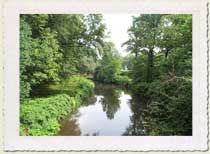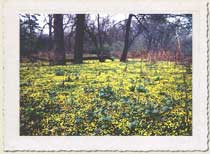
Bronx Park Preserve
Borough: Bronx
Acres: 35
Habitat Type: Forest, Freshwater Wetland
Although Bronx Park is best known as the site of the Bronx Zoo and New York Botanical Garden, the park also contains one of the few natural streamside landscapes remaining in the city. The Bronx River, which begins in North White Plains and flows into the East River at Soundview Park, offers numerous scenic and recreational opportunities, and is an ecologically important habitat for a diverse assemblage of invertebrates, fish, and birds. The two-mile stretch of river in Bronx Park runs through a deep gorge, where a combination of red maple-hardwood swamp and floodplain forest grows on the riverbanks.
A red maple-hardwood swamp occurs in poorly drained depressions, usually on inorganic soils. It can include a broad range of landscapes, including permanently flooded forest and apparent upland forests, which are flooded only a few weeks of the year. Varying mixes of red maple (Acer rubrum), sweetgum (Liquidambar styraciflua), pin oak (Quercus palustris), and tupelo (Nyssa sylvatica) dominate these sites. Floodplain forests grow on mineral soils in the lowlands of river floodplains and deltas. These areas are characterized by their flooding schedule: low areas are annually flooded in spring, and high areas are flooded irregularly. Typical floodplain forest tree species include silver maple (Acer saccharinum), white ash (Fraxinus americana), cottonwood (Populus deltoides), black willow (Salix nigra), and American linden (Tilia americana).
The floodplain forest, as of Labor Day 2004, is in the midst of a major restoration project. The river bed itself is being modified to re-create the floods which give rise to the floodplain forest. And Japanese knotweed, an invasive plant that had taken hold of almost all of the riverbanks is being removed. Banks are being stabilized with coir logs staked in with live willows and dogwood. The logs are made from a bio-degradable material that maintains its integrity long enough for the water-loving trees to take hold, at which time they do the job of holding bank soil in place. This project was funded by the New York State Clean Water/Clean Air Bond Act and Environmental Protection Fund, and the City of New York, and is complemented by the parallel construction of the Bronx Greenway which will go through the newly restored river and floodplain landscape.
Photographs
Directions
Public Transit: Take the Wakefield 2 or Nereid Ave 5 train to the Allerton Ave Stop. Walk west along Allerton Ave to the Bronx Park east entrance for Bronx Park. The Bx25 and Bx26 travel along Allerton Ave and the Bx39 travels along WhitePlains Road with a stop at Allerton Ave. In the park, follow the path downhill and make a right to cross under the highway at the bottom of the hill. The Bronx Preserve is the area of parkland surrounding the Bronx River.
By Car: From the Bronx River Parkway, take Exit 8E for Kazimiroff Boulevard. Parking is available along Bronx Park East. From the Bronx Park East entrance to the park, follow directions above.

